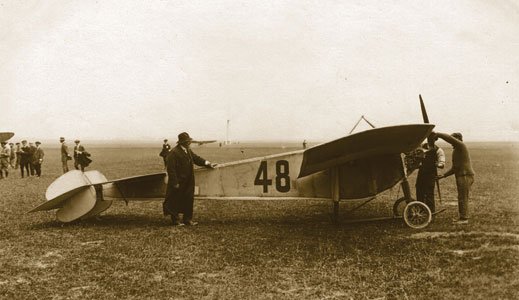The Airplane’s Infancy
Excerpted from “Training Aeronautical Engineers,” by Charles M. Chapin, in the July 1913 issue of The Technology Review:

When the flying machine first publicly appeared in this country, back in 1908, it will be remembered what universal enthusiasm was aroused . . . Schools all over the country founded aero clubs and went to work building aeroplanes and gliders with a vim which did credit to their energy rather than to their understanding . . . The only reason why some of the aeroplane builders did not come to grief was because none of them succeeded in producing a machine which could get an appreciable distance above the ground.
To the rule of general hysteria, however, there was one notable exception. As long ago as 1896, at [MIT], through the work of Gaetano Lanza, … a beginning was made in a direction where educational institutions could really be of service . . . His experiments were directed mainly to ascertain the lift and drift of surfaces at different angles in air-currents of varying speed. It is due to this experimentation that aviation and aeroplane construction has been raised from an art to a science. Formerly it was necessary for the builder to work by rule-of-thumb methods. He brought out his machine, not knowing whether or not it would fly, and altered here and there until he was able to get into the air. He was not certain, until he tried it, how much support a given curve of surface, driven at a given speed, would afford him. Only from actual flight could he estimate the varying head resistance of different sizes and arrangements of bracing, chassis, and out-rigging.
Today he either has the information already at hand, or can obtain it from an engineer. In fact, the development of the Nieuport monoplane, the first speed craft, was wholly scientific. Nieuport worked out his figures by laboratory experiment and applied the result to a full-sized machine, knowing just what to expect before it had left the ground. All of the European constructors have been forced to follow this method.
The lack of this exact knowledge in America has proved to be a great handicap, and already steps are being taken to remedy it. Last month President Taft, it will be recalled, named a commission to consider the establishment of a national laboratory for aerial research. All governments, however, move slowly, and none more so than that of the United States. It is imperative that steps be taken immediately to build a laboratory if America is to fall no further behind in the race for the supremacy of the air.
Keep Reading
Most Popular
Large language models can do jaw-dropping things. But nobody knows exactly why.
And that's a problem. Figuring it out is one of the biggest scientific puzzles of our time and a crucial step towards controlling more powerful future models.
How scientists traced a mysterious covid case back to six toilets
When wastewater surveillance turns into a hunt for a single infected individual, the ethics get tricky.
The problem with plug-in hybrids? Their drivers.
Plug-in hybrids are often sold as a transition to EVs, but new data from Europe shows we’re still underestimating the emissions they produce.
Stay connected
Get the latest updates from
MIT Technology Review
Discover special offers, top stories, upcoming events, and more.